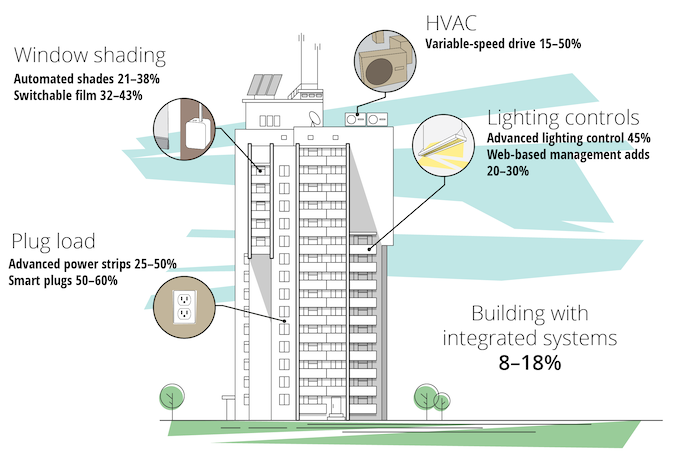Exciting new opportunities are emerging for commercial buildings to optimize their energy use. These include not only innovative technologies, but also new approaches to system design, building operations, and financing. ACEEE explores three of these opportunities in new topic briefs, released today, as part of our Emerging Opportunities for Buildings series.
Integrated building systems use sensors, controls, and software to manage energy use and optimize performance. Studies show whole-building energy savings of 8-18% with introduction of smart building management systems, but more data are needed from a more diverse set of projects. Other benefits to building owners, managers, and occupants include enhanced fault detection, automation, and improved occupant comfort. Efficiency programs are pursuing demonstrations, pilots, and programs to promote these systems and expand experience with the technology and data collection on savings and benefits. These efforts can help increase adoption of these systems in more commercial building sectors and across building sizes.
Energy storage offers another opportunity for energy efficiency and enhanced energy management in buildings. Thermal energy and battery storage systems can increase peak demand savings for building owners and potentially generate additional cost savings through equipment downsizing. Owners, managers, utilities, other program administrators, and the broader community can also benefit from the added grid flexibility and resilience capabilities these technologies provide. Program administrators are implementing several approaches for energy storage, ranging from technical assistance and rebates to real-time energy storage management. Some utilities are installing energy storage systems on customer premises under ongoing utility ownership and control.
As building owners and managers consider these and other opportunities to improve energy performance in their facilities, vendors are offering innovative models for financing the installation and operation of these technologies and other efficiency opportunities. Our third brief focuses on efficiency as a service (EaaS), a model where the service provider maintains ownership of installed equipment while the customer pays for the energy services provided. The typical EaaS model shifts the burden of financing, owning, installing, and managing the performance of energy assets from the customer to the service provider. A number of providers have entered the market to offer their own EaaS solutions. Case studies show savings range from 10% for a comprehensive LED lighting upgrade to 20-25% for more comprehensive retrofits. EaaS customers benefit from upfront cost savings for efficiency projects, off-balance sheet financing, operations and maintenance savings, lower operational risks, and the opportunity to couple efficiency upgrades with introduction of distributed energy resources including demand response, energy storage, and renewable energy.
In the coming months, ACEEE will release more briefs in the Emerging Opportunities in Buildings series.
Interested in sponsoring future briefs in the Emerging Opportunities Series? Contact Jennifer Amann or Liz Hale for details.


